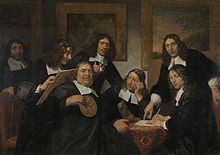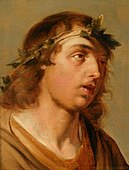Jan de Bray: Difference between revisions
m Fixing broken link to RKDartists |
m Removing from Category:Artists from Haarlem using Cat-a-lot |
||
| (24 intermediate revisions by 14 users not shown) | |||
| Line 1: | Line 1: | ||
{{short description|Dutch painter}} |
|||
[[File:Couplede bray.jpg|thumb|right|''De Bray and his wife as Ulysses and Penelope'', 1668]] |
[[File:Couplede bray.jpg|thumb|right|''De Bray and his wife as Ulysses and Penelope'', 1668]] |
||
'''Jan de Bray''' ( |
'''Jan de Bray''' ({{Circa|1627}} – April 4, 1697) was a [[Dutch Golden Age painter]].<ref>[https://www.getty.edu/vow/ULANFullDisplay?find=&role=&nation=&subjectid=500032401 ULAN]: Middle name "Salomonsz" ("son of Salomon"), various spellings.</ref> He lived and worked in [[Haarlem]] until the age of 60, when he went bankrupt and moved to [[Amsterdam]]. |
||
| ⚫ | [[File:Jan de Bray - The de Bray Family (The Banquet of Antony and Cleopatra) - WGA03122.jpg|thumb|In his family portrait depicting the banquet of Antony and [[Cleopatra]] at the moment when Cleopatra puts her earring in the wine, Jan is depicted standing on the left. In the earlier version, the sons look up to the father, and in this version, the brothers (all since deceased except for Dirck) look at Jan.]] |
||
| ⚫ | Jan de Bray was influenced by his father [[Salomon de Bray]], and the portraitists [[Bartholomeus van der Helst]], and [[Frans Hals]]. De Bray's works are mainly portraits, often of groups, and [[history painting]]s. He specialised in combining the two genres in the [[portrait historié]], portraits of historical figures using contemporary figures, including himself and his family. Among his finest works are two versions of the ''Banquet of Cleopatra'', using his own family, including himself, as models ([[Royal Collection]], 1652, and [[Currier Museum of Art]], [[New Hampshire]], 1669). The second version has great pathos, as most of those depicted had died in the plague of 1663–4.<ref>[[Christopher Lloyd (art historian)|Christopher Lloyd]], ''Enchanting the Eye, Dutch Paintings of the Golden Age'', pp. 49-52, Royal Collection Publications, 2004, {{ISBN|1-902163-90-7}}.</ref> |
||
==Biography== |
==Biography== |
||
| ⚫ | Jan de Bray was born in Haarlem. According to Houbraken he was the most famous pupil of his father, the painter, architect and poet [[Salomon de Bray]].<ref name=Houbraken>{{in lang|nl}} [http://www.dbnl.org/tekst/houb005groo01_01/houb005groo01_01_084.htm Salomon de Bray Biography]{{dead link|date=November 2017 |bot=InternetArchiveBot |fix-attempted=yes }} in ''De groote schouburgh der Nederlantsche konstschilders en schilderessen'' (1718) by [[Arnold Houbraken]], courtesy of the [[Digital library for Dutch literature]]</ref> Houbraken called Jan the "pearl in Haarlem's crown".<ref name=Houbraken/> Houbraken saw a painting by de Bray of [[David]] and the Return of the [[Ark of the Covenant]] in the collection of [[Arnoud van Halen]] in Amsterdam, dated 1697, that he admired for its realistic flesh tones in the forms of David playing the harp and the [[Levite]]s behind him. Houbraken also mentioned some black and red chalk drawings by him that he saw at the Amsterdam home of Isaak del Court.<ref name=Houbraken/> |
||
[[File:Jan de Bray 002.jpg|right|thumb|The Painter's Guild in 1675. Jan de Bray's self-portrait is the second from the left, and his brother [[Dirck de Bray]] is standing upper right.]] |
[[File:Jan de Bray 002.jpg|right|thumb|The Painter's Guild in 1675. Jan de Bray's self-portrait is the second from the left, and his brother [[Dirck de Bray]] is standing upper right.]] |
||
| ⚫ | |||
| ⚫ | Jan de Bray was born in |
||
He spent most of his career working in [[Haarlem]], where he was for many years dean of the [[Haarlem Guild of St. Luke]].<ref name=RKD>[https://rkd.nl/en/explore/artists/12194 Jan de Bray] |
He spent most of his career working in [[Haarlem]], where he was for many years dean of the [[Haarlem Guild of St. Luke]].<ref name=RKD>[https://web.archive.org/web/20160304211420/https://rkd.nl/en/explore/artists/12194 Jan de Bray] in the [[RKD]]</ref> His brother [[Dirck de Bray]] was a flower painter who later became a monk in the monastery at Gaesdonck near [[Goch]].<ref name=Houbraken/> His brother [[Joseph de Bray|Joseph]] was also a painter.<ref name=RKD/> His mother was Anna Westerbaen, the sister of the painter Jan Westerbaen<ref name=RKD/> and the poet [[Jacob Westerbaen]]. His sister Cornelia married [[Jan Lievens]]. |
||
De Bray survived most of his family during an outbreak of the plague in Haarlem in 1664. He lost his father and |
De Bray survived most of his family during an outbreak of the plague in Haarlem in 1664. He lost his father, his brother Joseph and three other siblings within two months of each other. His wives – Maria van Hees whom he married 21 October 1668,<ref name="books.google.com">[https://books.google.com/books?id=1tc9AAAAcAAJ&pg=PA247 "Geschiedkundige aanteekeningen over Haarlemsche Schilders en Andere Beoefenaren van de Beeldende Kunsten" p. 247 ''books.google.com''] 23 September 2011</ref> Margaretha de Meyer whom he married in 1672,<ref>[https://web.archive.org/web/20120321233522/http://www.russianpaintings.net/artist_museum.vphp?author=639&sort=added "Jan de Bray" ''russianpaintings.net''] 23 September 2011</ref> and Victoria Stalpert van der Wielen whom he married 30 January 1678<ref name="books.google.com"/> – each died before him; Victoria shortly after giving birth to their son, Johan Lucas. In 1689 he was declared bankrupt as a Haarlem citizen and moved to Amsterdam, where he died, though he was buried in Haarlem.<ref name=RKD/> |
||
==Works== |
|||
| ⚫ | [[File:Jan de Bray - The de Bray Family (The Banquet of Antony and Cleopatra) - WGA03122.jpg|thumb|In his family portrait depicting the banquet of Antony and [[Cleopatra]] at the moment when Cleopatra puts her earring in the wine, Jan is depicted standing on the left. In the earlier version, the sons look up to the father, and in this version, the brothers (all since deceased except for Dirck) look at Jan.]] |
||
<gallery widths="180px" heights="170px"> |
|||
| ⚫ | Jan de Bray was influenced by his father, [[Bartholomeus van der Helst]], and [[Frans Hals]]. De Bray's works are mainly portraits, often of groups. He specialised in historical |
||
File:Jan de Bray - Cleopatra puts the pearl in the wine - Royal Collection - 1652 - RCIN 404756.jpg|''Cleopatra puts the pearl in the wine'', [[Royal Collection]], 1652 (first version) |
|||
<gallery> |
|||
| ⚫ | |||
File:De Bray - Bacchus.jpg|''Bacchus'', showing loose brush strokes |
File:De Bray - Bacchus.jpg|''Bacchus'', showing loose brush strokes |
||
File:De Bray - Adoration.jpg|''The Adoration of the Magi'', a typical altarpiece for a [[schuilkerk]] |
File:De Bray - Adoration.jpg|''The Adoration of the Magi'', a typical altarpiece for a [[schuilkerk]] |
||
File:Jan de Bray - Head of a Boy - Walters 37270.jpg| ''Head of a Boy''. [[The Walters Art Museum]]. |
File:Jan de Bray - Head of a Boy - Walters 37270.jpg| ''Head of a Boy''. [[The Walters Art Museum]]. |
||
File:Jan de Bray 003.jpg|''Jael and Sisera'', 1659. [[York Museums Trust]]. |
|||
</gallery> |
</gallery> |
||
{{Commons category|Jan de Bray}} |
|||
==References== |
==References== |
||
| Line 26: | Line 28: | ||
==External links== |
==External links== |
||
{{Commons}} |
|||
*[http://www.artnet.com/artist/3003/jan-de-bray.html Jan de Bray] on [[Artnet]] |
*[http://www.artnet.com/artist/3003/jan-de-bray.html Jan de Bray] on [[Artnet]] |
||
*[http://www.pubhist.com/person/162/jan-de-bray Works and literature] on PubHist |
*[http://www.pubhist.com/person/162/jan-de-bray Works and literature] on PubHist |
||
*Murray, P. & L. (1996). ''Dictionary of art and artists'' (p. 65). London: Penguin Books. {{ISBN|0-14-051300-0}}. (For details see: [[Talk:Jan de Bray/Sources|Sources]]) |
*Murray, P. & L. (1996). ''Dictionary of art and artists'' (p. 65). London: Penguin Books. {{ISBN|0-14-051300-0}}. (For details see: [[Talk:Jan de Bray/Sources|Sources]]) |
||
*[https://web.archive.org/web/20060930023038/http://www.nga.gov/exhibitions/2005/debray/debray_brochure.pdf Jan De Bray and the Classical Tradition at the National Gallery of Art, Washington - 16pp pdf exhibition brochure] |
*[https://web.archive.org/web/20060930023038/http://www.nga.gov/exhibitions/2005/debray/debray_brochure.pdf Jan De Bray and the Classical Tradition at the National Gallery of Art, Washington - 16pp pdf exhibition brochure] |
||
*[https://rkd.nl/en/explore/artists/12194 Entry for Jan de Bray] |
*[https://web.archive.org/web/20160304211420/https://rkd.nl/en/explore/artists/12194 Entry for Jan de Bray] in the [[RKD]], the Netherlands Institute for Art History |
||
{{Authority control}} |
{{Authority control (arts)}} |
||
{{DEFAULTSORT:Bray, Jan De}} |
{{DEFAULTSORT:Bray, Jan De}} |
||
[[Category:1627 births]] |
[[Category:1627 births]] |
||
[[Category:1697 deaths]] |
[[Category:1697 deaths]] |
||
[[Category:Artists from Haarlem]] |
|||
[[Category:Dutch Golden Age painters]] |
[[Category:Dutch Golden Age painters]] |
||
[[Category:Dutch male painters]] |
[[Category:Dutch male painters]] |
||
[[Category: |
[[Category:Painters from Haarlem]] |
||
Latest revision as of 03:09, 3 August 2023

Jan de Bray (c. 1627 – April 4, 1697) was a Dutch Golden Age painter.[1] He lived and worked in Haarlem until the age of 60, when he went bankrupt and moved to Amsterdam.

Jan de Bray was influenced by his father Salomon de Bray, and the portraitists Bartholomeus van der Helst, and Frans Hals. De Bray's works are mainly portraits, often of groups, and history paintings. He specialised in combining the two genres in the portrait historié, portraits of historical figures using contemporary figures, including himself and his family. Among his finest works are two versions of the Banquet of Cleopatra, using his own family, including himself, as models (Royal Collection, 1652, and Currier Museum of Art, New Hampshire, 1669). The second version has great pathos, as most of those depicted had died in the plague of 1663–4.[2]
Biography[edit]
Jan de Bray was born in Haarlem. According to Houbraken he was the most famous pupil of his father, the painter, architect and poet Salomon de Bray.[3] Houbraken called Jan the "pearl in Haarlem's crown".[3] Houbraken saw a painting by de Bray of David and the Return of the Ark of the Covenant in the collection of Arnoud van Halen in Amsterdam, dated 1697, that he admired for its realistic flesh tones in the forms of David playing the harp and the Levites behind him. Houbraken also mentioned some black and red chalk drawings by him that he saw at the Amsterdam home of Isaak del Court.[3]

He spent most of his career working in Haarlem, where he was for many years dean of the Haarlem Guild of St. Luke.[4] His brother Dirck de Bray was a flower painter who later became a monk in the monastery at Gaesdonck near Goch.[3] His brother Joseph was also a painter.[4] His mother was Anna Westerbaen, the sister of the painter Jan Westerbaen[4] and the poet Jacob Westerbaen. His sister Cornelia married Jan Lievens.
De Bray survived most of his family during an outbreak of the plague in Haarlem in 1664. He lost his father, his brother Joseph and three other siblings within two months of each other. His wives – Maria van Hees whom he married 21 October 1668,[5] Margaretha de Meyer whom he married in 1672,[6] and Victoria Stalpert van der Wielen whom he married 30 January 1678[5] – each died before him; Victoria shortly after giving birth to their son, Johan Lucas. In 1689 he was declared bankrupt as a Haarlem citizen and moved to Amsterdam, where he died, though he was buried in Haarlem.[4]
-
Cleopatra puts the pearl in the wine, Royal Collection, 1652 (first version)
-
"David and the Ark of the Covenant", 1670
-
Bacchus, showing loose brush strokes
-
The Adoration of the Magi, a typical altarpiece for a schuilkerk
-
Head of a Boy. The Walters Art Museum.
-
Jael and Sisera, 1659. York Museums Trust.
References[edit]
- ^ ULAN: Middle name "Salomonsz" ("son of Salomon"), various spellings.
- ^ Christopher Lloyd, Enchanting the Eye, Dutch Paintings of the Golden Age, pp. 49-52, Royal Collection Publications, 2004, ISBN 1-902163-90-7.
- ^ a b c d (in Dutch) Salomon de Bray Biography[permanent dead link] in De groote schouburgh der Nederlantsche konstschilders en schilderessen (1718) by Arnold Houbraken, courtesy of the Digital library for Dutch literature
- ^ a b c d Jan de Bray in the RKD
- ^ a b "Geschiedkundige aanteekeningen over Haarlemsche Schilders en Andere Beoefenaren van de Beeldende Kunsten" p. 247 books.google.com 23 September 2011
- ^ "Jan de Bray" russianpaintings.net 23 September 2011
External links[edit]
- Jan de Bray on Artnet
- Works and literature on PubHist
- Murray, P. & L. (1996). Dictionary of art and artists (p. 65). London: Penguin Books. ISBN 0-14-051300-0. (For details see: Sources)
- Jan De Bray and the Classical Tradition at the National Gallery of Art, Washington - 16pp pdf exhibition brochure
- Entry for Jan de Bray in the RKD, the Netherlands Institute for Art History






